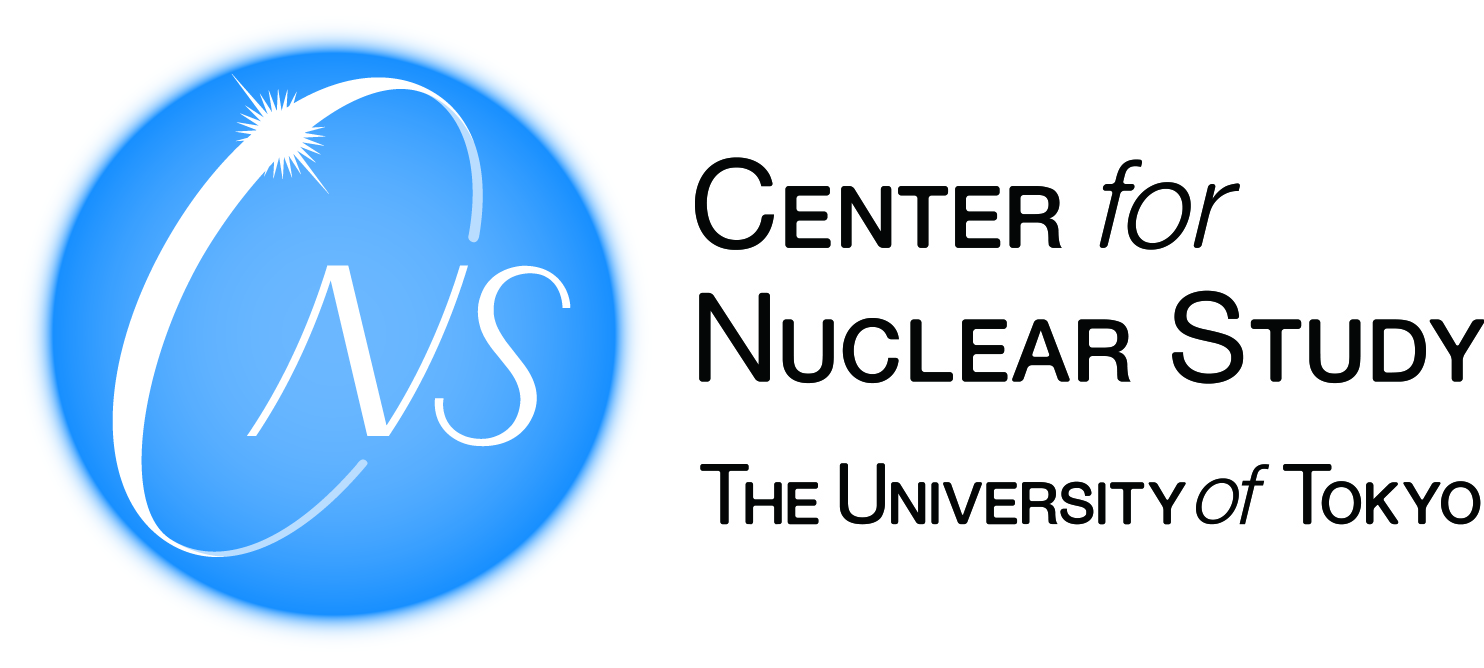Education
東京大学原子核科学研究センター (CNS) では、原子核からクォークに至るハドロン多体系の物理を研究しています。加速器技術の発展に伴い、我々は従来到達し得なかった領域に踏み込む道具をこの手に得ることになりました。CNS と強い研究連携体制にある理化学研究所の RI ビームファクトリー、とりわけ東大CNSの建設した、SHARAQ、CRIBという2つの大型実験装置はその代表であり、さらに低速エキゾティックRIビームを生み出すためのOEDO計画が進行中です。 CNS は 8 人の教員(教授 2, 准教授 3, 講師 1, 助教 2)と大学院生・ポスドクを中心としたメンバーで、これらの巨大加速器施設における最先端研究を推進しています。各研究室の紹介はこちらをご覧ください。また、大学院生への進学を希望される方は理学系研究科の進学ガイダンス、および入学案内も合わせてご確認ください。
Labs in CNS
原子核は様々な量子現象の舞台です。一粒子運動と集団運動の拮抗、自発的対称性の破れ(回転対称性、反転対称性、ゲージ対称性…)、コヒーレンス、量子もつれと干渉現象…。原子核の実験技術は飛躍的な発展のさなかにあります。私たちは最先端のガンマ線トラッキング検出器と希少原子核ビームを組み合わせて原子核の種類や励起エネルギー、さまざまな量子数を変化させることで原子核に現れるさまざまな量子構造を研究しています。
一例として回転対称性や反転対称性を自発的にやぶった状態の探索があります。原子核は中性子と陽子(あわせて核子)が自己束縛する孤立した有限多体系であるため、太陽系における太陽のような中心を持たず、その形状をその構成要素である核子たち自身で「民主的に」決めることになります。回転対称な空間に浮かぶこの系は古典的には回転対称な形状、すなわち球形をとりますが、原子核の場合、量子性のために多くの場合変形していることが分かっています。これは量子系における自発的対称性の破れの典型例で、ゲージ空間における対称性の破れと理解できる物性における超伝導現象など、さまざまなスケールの量子系とのつながりがあります。原子核の変形はよく研究されていますが、これまでに実験で知られているのは主として軸対称四重極変形、すなわち、ラグビーボール型変形(プロレート変形)やミカン型変形(オブレート変形)で、理論的にはもっと変わった変形も多数予言されています。例えば、非軸対称(三軸非対称)の四重極変形や、空間反転対称性すら破る洋梨形変形やテトラポット型変形(八重極変形)、軸対称四重極変形のなかでも非常に変形度の大きなハイパー変形などがあげられます。こうした形状は中性子数と陽子数の関数として変化していきますが、原子核科学研究センターがRIビームファクトリーにもつ OEDO/SHARAQ ビームラインで広い領域の中性子数と陽子数の原子核を生成し、ガンマ線トラッキング検出器で測定することを目指しています。

- Francium EDM Search: Using an optical-lattice interferometer to measure the permanent electric dipole moment of francium atoms.
- Anapole Moment Studies: Investigating how the weak interaction propagates through a nuclear medium.
- Laser-Cooled Polar Molecules: Developing Fr–Sr molecules for precision tests of fundamental symmetries.

Approximately 3,000 nuclides have been confirmed experimentally, and nuclear‐structure models predict another 3,000 yet to be observed. Most of these are radioactive isotopes—bound by the strong force but decaying via the weak interaction—and over ten radioactive-beam facilities worldwide are racing to study them. As the host laboratory for the world-unique slow-beam system OEDO coupled with the SHARAQ magnetic spectrometer, we collaborate with users from around the globe to unravel how nucleons self-organize in finite quantum many-body systems.
In particular, we’re experimentally probing recently discovered phenomena such as shape coexistence, exotic deformations, and the Bose–Einstein-condensate to BCS crossover. We also investigate the astrophysical origins of heavy elements by measuring neutron-capture cross sections on neutron-rich nuclei. To support these programs, we are developing advanced detector technologies—high-efficiency γ-ray arrays, recoil-particle detectors based on silicon strip sensors, and ultra-thin diamond detectors—to deliver the timing, position resolution, and radiation hardness these experiments demand.

Nuclei—finite many-body systems made up of only a few dozen to around a hundred nucleons—exhibit a rich variety of structural modes determined by their proton–neutron composition. As finite systems, they possess macroscopic attributes such as surface and shape. By probing a nucleus via nuclear scattering, one can induce rotational and vibrational motion; these processes, known as nuclear collective excitations, directly reflect fundamental properties like nuclear stiffness. The Exotic Nuclear Reactions Group investigates these responses to uncover the interactions that generate novel collective behaviors and exotic structural phases.
With unstable beams from RIBF, we can now study highly asymmetric nuclei in scattering experiments—systems that were previously inaccessible. Our core focus is on their spin and isospin responses. To enable these measurements, we have developed specialized neutron detectors such as the PANDORA array, and we periodically produce new unstable beams (for example, spin isomers). We also use one exotic nucleus to probe another—searching for new resonant states via in-beam scattering. Experimental nuclear physics is entering a golden era in which straightforward ideas—like using high–angular-momentum beams to efficiently populate high-spin states—can be tested and realized.


The mechanism by which stars shine in the universe and explosive phenomena such as supernovae occur can be explained by the action of small atomic nuclei inside atoms. "Nuclear astrophysics" is a research field that connects celestial bodies floating in the vast universe with tiny atomic nuclei. The power of nuclear astrophysics is needed to answer questions such as how the elements around us were synthesized throughout the history of the universe, and how stars in the universe burn and explode.
Yamaguchi Lab./Nuclear Astrophysics Group is working with researchers from all over the world to solve various mysteries of the universe, from the Big Bang nucleosynthesis, the first element synthesis in the universe, to the frequent explosive phenomena in the universe, such as X-ray bursts, using a unique device "CRIB" that can generate unstable nuclear beams at the temperatures of explosive stellar environments.
Nuclear astrophysics has become a major theme in nuclear physics worldwide. While the main research of Yamaguchi Lab. is based in Japan, we are conducting unique research in a highly international research environment.


The many-body amplification of tiny symmetry-breaking effects may lie at the heart of life’s homochirality—why DNA exists only as a right-handed helix and why all biologically used amino acids are the L-enantiomers. We propose that the dense nuclear medium of heavy elements can amplify fundamental symmetry violations to observable levels. To test this, we have built a hybrid trapping system that confines heavy neutral atoms and heavy ions within the same electromagnetic potential. By performing simultaneous, high-precision quantum measurements on both species—probing atomic energy levels, spin precession, and hyperfine transitions—we aim to detect symmetry-violating interactions originating at the quark and lepton level. This experiment will map how the smallest symmetry breakings are amplified, step by step, from quarks to nuclei to atoms, shedding light on the mechanism that seeds the asymmetric matter structures we see in nature.

ビッグバン直後の初期宇宙では、どのようにして粒子や原子核が生まれたのでしょうか。私は、国内外の加速器実験を通じて、初期宇宙に存在したと考えられるクォーク・グルーオン・プラズマを実験的に再現し、その性質を解明することで、強い相互作用が支配する極限状態の物質を理解することを目指しています。特に、共鳴粒子の生成と崩壊、軽い(反)原子核の形成過程を精密に測定することで、ハドロン物理と原子核物理をつなぐ研究を推進しています。これらの研究は、原子核内部における集団運動や変形といった核構造の理解にも新たな視点を与えるものです。最終的には、物質の形成メカニズムと、強い相互作用によって生み出される多様な物質状態を実験的に再構築することを目指しています。

原子核は、陽子と中性子という二種類の粒子が、数個から数百個集まってできた量子多体系です。 それぞれの粒子数を変えることで、形状や量子構造、崩壊の仕方など、その性質が大きく変化することが知られています。 しかし、この多様な原子核の性質を統一的に記述できる理論は、まだ確立されていません。
私たちは、地球上には存在しない不安定な原子核の性質を実験的に調べることで、原子核という量子多体系の普遍的な理解を目指しています。 これらの研究は、単なる原子核物理の探究にとどまらず、中性子星など極限天体の構造解明や、物質・反物質の非対称性の起源を探る研究にもつながる重要な意義を持っています。 たとえば、反転対称性が破れた形状をもつ特定の不安定核は、宇宙における対称性の破れを検証する新しい手法に応用され得ます。 また、不安定原子核の崩壊様式を明らかにすることは、太陽系を構成する元素がどこで合成され、どのように安定核へと変化してきたかを理解する上でも重要です。
私たちのグループでは、理化学研究所RIBFおよびOEDOをはじめとする国内外の最先端不安定核生成施設で実験を行い、次世代検出器の開発や大規模データ解析環境の構築など、最先端の実験技術開拓にも取り組んでいます。 学生は、実験提案から装置開発、データ解析、成果発表に至るまで、すべての段階に主体的に関わることができ、国際共同研究に参加する機会も豊富です。 世界最先端の実験施設を活用し、量子多体系・核構造・宇宙物理・素粒子物理の架け橋となる研究を共に切り拓いていきましょう。
Graduate School Admission Guidance
RIKEN RI Beam Factory tour by Center for Nuclear Study
Tour and lectures are conducted for the RIKEN RI Beam Factory /Center for Nuclear Study of U-Tokyo, the base facility for cutting-edge nuclear physics
May 10 (Sat), 2025, 13:00-
RIKEN (Hirosawa 2-1, Wako, Saitama)
Registration form here
Admission guidance for the Graduate School of Science, Department of Physics (online)
May 31 (Sat), 2025, 10:00-15:30
This guidance includes the introduction of the A2 sub-course, to which CNS belongs.
Details will be shown atthe web page of the Department of PhysicsCounseling session with CNS professors will be held for 13:30-15:30, as a hybrid (in-person+online) meeting.
Details, including zoom URL, will be shown here later.
Guidance for the admission of the A2 sub-course Labs.
To be held early June. Details will be added soon.
CNS Lab. Guidance
To be held at Room 233, Sci Bldg. 1 (Hongo), on June 13 (Fri), 2025, 16:30-18:00
This guidance includes the introduction of each Lab. at CNS.
Facility tour of CNS Wako/RIKEN RIBF
A facility tour will be conducted on Jun 14 (Sat) afternoon, 2025. Please ask the professors for details.
A personal tour can be conducted anytime on demand. Please feel free to ask each professor.
Contact about the CNS Guidance: T. Gunjigunji@cns.s.u-tokyo.ac.jp)





